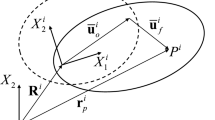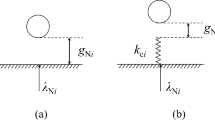Abstract
In this study, we propose an efficient fixed-time increment-based numerical scheme for data-driven analysis of general multibody dynamics (MBD) problems combining deep neural network (DNN) modeling and principal component analysis (PCA), avoiding local fluctuation of the time transient response that occurred in other works. Output results of the transient dynamics simulation can be expressed as general displacement, velocity, and acceleration, which can also be represented in a reduced dimension by the PCA. This data set is expressed in a fixed-time increment based format, leading to a large data set that is advantageous for training to construct an efficient DNN meta-model. In addition, the number of samples is also significantly reduced. As a result, the training cost is dramatically reduced compared to the simulation without PCA despite a smaller number of samples being used. To demonstrate the performance of the proposed scheme, we solve three benchmark problems: a double pendulum, damped spherical elastic pendulum, and vibrating transmission. From the results, it was found that, when the proposed scheme is used, the training time can be drastically reduced while maintaining high accuracy.
















Similar content being viewed by others
Data availability
The raw/processed data required to reproduce these findings cannot be shared at this time as the data also form part of an ongoing study.
References
Wehage RA, Haug EJ (1982) Generalized coordinate partitioning for dimension reduction in analysis of constrained dynamic systems. J Mech Des 104:247–255
Shabana AA (2003) Dynamics of multibody systems. Cambridge University Press
Wehage KT, Wehage RA, Ravani B (2015) Generalized coordinate partitioning for complex mechanisms based on kinematic substructuring. Mech Mach Theory 92:464–483
Brüls O, Duysinx P, Golinval J-C (2006) A model reduction method for the control of rigid mechanisms. Multibody SysDyn 15:213–227
Brüls O, Duysinx P, Golinval JC (2007) The global modal parameterization for non-linear model-order reduction in flexible multibody dynamics. Int J Numer Meth Eng 69:948–977
Naets F, Tamarozzi T, Heirman GH, Desmet W (2012) Real-time flexible multibody simulation with global modal parameterization. Multibody SysDyn 27:267–284
Masoudi R, Uchida T, McPhee J (2015) Reduction of multibody dynamic models in automotive systems using the proper orthogonal decomposition. J Comput Nonlinear Dyn 10:031007
Cuadrado J, Dopico D, Naya MA, Gonzalez M (2004) Penalty, semi-recursive and hybrid methods for MBS real-time dynamics in the context of structural integrators. Multibody SysDyn 12:117–132
Pan Y, Dai W, Xiong Y, Xiang S, Mikkola A (2020) Tree-topology-oriented modeling for the real-time simulation of sedan vehicle dynamics using independent coordinates and the rod-removal technique. Mech Mach Theory 143:103626
Pan Y, Dai W, Huang L, Li Z, Mikkola A (2021) Iterative refinement algorithm for efficient velocities and accelerations solutions in closed-loop multibody dynamics. Mech Syst Signal Process 152:107463
Bayo E, de Jalon JG, Avello A, Cuadrado J (1991) An efficient computational method for real time multibody dynamic simulation in fully Cartesian coordinates. Comput Methods Appl Mech Eng 92:377–395
Cossalter V, Lot R (2002) A motorcycle multi-body model for real time simulations based on the natural coordinates approach. Veh Syst Dyn 37:423–447
Valasek M, Sika Z, Vaculin O (2007) Multibody formalism for real-time application using natural coordinates and modified state space. Multibody SysDyn 17:209–227
Pappalardo CM (2015) A natural absolute coordinate formulation for the kinematic and dynamic analysis of rigid multibody systems. Nonlinear Dyn 81:1841–1869
Ros J, Plaza A, Iriarte X, Pintor JM (2018) Symbolic multibody methods for real-time simulation of railway vehicles. Multibody SysDyn 42:469–493
Ting J-A, Mistry MN, Peters J, Schaal S, Nakanishi J (2006) A Bayesian approach to nonlinear parameter identification for rigid body dynamics. In: Robotics: science and systems II, vol 2016. MIT Press, pp 32–39
Blanco-Claraco J, Torres-Moreno J, Giménez-Fernández A (2015) Multibody dynamic systems as Bayesian networks: applications to robust state estimation of mechanisms. Multibody SysDyn 34:103–128
Ye Y, Shi D, Krause P, Hecht M (2019) A data-driven method for estimating wheel flat length. Vehicle Syst Dyn 58:1329–1347
Ye Y-G, Shi D-C, Poveda-Reyes S, Hecht M (2020) Quantification of the influence of rolling stock failures on track deterioration. J Zhejiang Univ-SCIENCE A 21:783–798
Kraft S, Causse J, Martinez A (2019) Black-box modelling of nonlinear railway vehicle dynamics for track geometry assessment using neural networks. Veh Syst Dyn 57:1241–1270
Martin TP, Zaazaa KE, Whitten B, Tajaddini A (2007), Using a multibody dynamic simulation code with neural network technology to predict railroad vehicle-track interaction performance in real time. In: International Design Engineering Technical Conferences and Computers and Information in Engineering Conference, 2007, pp 1881–1891
Ansari H, Tupy M, Datar M, Negrut D (2010) Construction and use of surrogate models for the dynamic analysis of multibody systems. SAE Int J Passeng Cars-Mech Syst 3:8–20
Angeli A, Naets F, Desmet W (2019) A machine learning approach for minimal coordinate multibody simulation. In: European Congress on computational methods in applied sciences and engineering, Springer, 2019, pp 417–424
Angeli A, Desmet W, Naets F (2021) Deep learning for model order reduction of multibody systems to minimal coordinates. Comput Methods Appl Mech Eng 373:113517
Byravan A, Fox D (2017) Se3-nets: learning rigid body motion using deep neural networks. In: 2017 IEEE International Conference on robotics and automation (ICRA). IEEE, pp 173–180
Choi H-S, An J, Han S, Kim J-G, Jung J-Y, Choi J, Orzechowski G, Mikkola A, Choi JH (2021) Data-driven simulation for general-purpose multibody dynamics using Deep Neural Networks. Multibody SysDyn 51:419–454
Han S, Choi HS, Choi J, Choi JH, Kim JG (2021) A DNN-based data-driven modeling employing coarse sample data for real-time flexible multibody dynamics simulations. Comput Methods Appl Mech Eng 373:113480
Ye YU, Huang P, Sun Y, Shi DC (2021) MBSNet: A deep learning model for multibody dynamics simulation and its application to a vehicle-track system. Mech Syst Signal Process 157:107716
Kurvinen E, Suninen I, Orzechowski G, Choi JH, Kim JG, Mikkola A (2021) Accelerating design processes using data-driven models. In: Real-time simulation for sustainable production. Routledge, pp 65–76
Wold S, Esbensen K, Geladi P (1987) Principal component analysis. Chemom Intell Lab Syst 2:37–52
Bayo E, Ledesma R (1996) Augmented Lagrangian and mass-orthogonal projection methods for constrained multibody dynamics. Nonlinear Dyn 9:113–130
Newmark NM (1959) A method of computation for structural dynamics. J Eng Mech Div 85:67–94
Paszke A, Gross S, Massa F, Lerer A, Bradbury J, Chanan G, Killeen T, Lin ZM, Gimelshein N, Antiga L, Desmaison A, Kopf A, Yang E, DeVito Z, Raison M, Tejani A, Chilamkurthy S, Steiner B, Fang L, Bai JJ, Chintala S (2019) PyTorch: an imperative style, high-performance deep learning library. Adv Neural Inf 32:8026–8037
Rumelhart DE, Hinton GE, Williams RJ (1986) Learning representations by back-propagating errors. Nature 323:533–536
Bergstra J, Bengio Y (2012) Random search for hyper-parameter optimization. J Mach Learn Res 13:281–305
He X, Zhao K, Chu X (2021) AutoML: a survey of the state-of-the-art. Knowl-Based Syst 212:106622
Ioffe S, Szegedy C (2015) Batch normalization: accelerating deep network training by reducing internal covariate shift. In: International conference on machine learning, vol 37. PMLR, pp 448–456
MATLAB (2022) Version R2022a. The MathWorks Inc, Natick, Massachusetts
RecurDyn, V9R4, Function Bay Inc.
Acknowledgements
This research was supported with the support of the Space Challenge Project (NRF-2020M1A3B8084736) of the National Research Foundation of Korea (NRF) funded by the government (Ministry of Science and ICT) in 2020.
Author information
Authors and Affiliations
Corresponding authors
Ethics declarations
Conflict of interest
The authors declare that they have no known competing financial interests or personal relationships that could have appeared to influence the work reported in this paper.
Additional information
Publisher's Note
Springer Nature remains neutral with regard to jurisdictional claims in published maps and institutional affiliations.
Rights and permissions
Springer Nature or its licensor (e.g. a society or other partner) holds exclusive rights to this article under a publishing agreement with the author(s) or other rightsholder(s); author self-archiving of the accepted manuscript version of this article is solely governed by the terms of such publishing agreement and applicable law.
About this article
Cite this article
Go, MS., Han, S., Lim, J.H. et al. An efficient fixed-time increment-based data-driven simulation for general multibody dynamics using deep neural networks. Engineering with Computers 40, 323–341 (2024). https://doi.org/10.1007/s00366-023-01793-z
Received:
Accepted:
Published:
Issue Date:
DOI: https://doi.org/10.1007/s00366-023-01793-z




